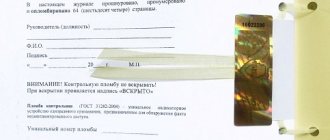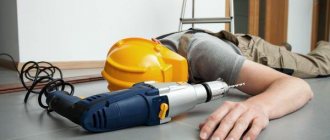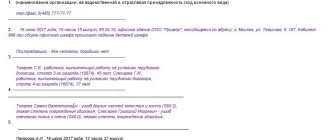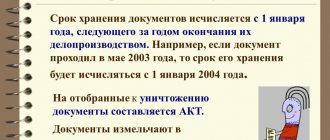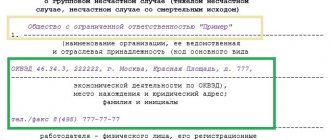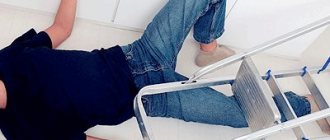What applies to industrial injuries?
Types of accidents at work
Industrial injuries are subject to recording and control. These include situations of receiving bodily injuries at an enterprise or during the labor process, including those inflicted by another person. This also includes:
- heatstroke;
- burns;
- frostbite;
- drowning;
- electric shock;
- injuries due to natural disasters;
- other emergency situations that are caused by the influence of external factors.
In the event of an accident, traumatic injuries are caused to health
Classification of injuries
Using general knowledge from the field of medicine, it is easy to name the main types of work-related injuries. So, depending on the traumatic object, it is customary to distinguish:
- cuts;
- burns;
- fractures;
- bruises;
- amputations;
- dislocations.
But the types of injuries and classification of injuries are much broader. Occupational injuries are classified according to the type of traumatic factor, the number of victims and the severity of the injuries. They, in turn, are divided into subclasses.
By type of traumatic factor:
- mechanical;
- thermal;
- chemical;
- electrical;
- combined.
By the number of victims of damage:
- single;
- group.
Injuries have visible and invisible consequences.
By severity of damage:
- lungs;
- heavy;
- fatal injuries.
IMPORTANT!
Any type of injury requires timely first aid. Sometimes a banal scratch becomes the cause of suppuration, which leads to undesirable consequences for the employee’s health, and, under certain circumstances, to death.
Occupational Health and Safety
Investigation and recording of industrial accidents
Labor protection at an enterprise involves the preparation, adoption and implementation of decisions that are related to the preservation of the life and health of employees during the performance of their work functions.
The following labor safety principles should be observed:
- All managers must be responsible for labor safety at the enterprise: from the chief director to the head of a structural unit;
- all employees of the enterprise must be involved in labor protection issues;
- All personnel must undergo occupational safety training.
The employer must work on labor protection
The head of the enterprise is obliged to organize the following work in the field of labor protection:
- introduce occupational safety and health policies;
- implement targeted government programs;
- protect the legitimate interests of workers who are involved in an accident at work;
- carry out training of workers on labor protection;
- investigate and maintain records of emergencies;
- prevent accidents at the enterprise;
- organize a state examination of the working conditions of workers.
What is NS in production
An accident is an unforeseen emergency that causes injury or death to a person. According to Article 227 of the Labor Code of the Russian Federation, such an incident at an enterprise is a process as a result of which a person suffered harm to his health or died.
The consequences of an accident can be:
- body trauma with thermal lesions;
- damage from electrical energy or radiation;
- injury from explosions and building collapses;
- bite with a wound from insects and animals at the enterprise;
- damage from a natural disaster;
- the occurrence of a chronic disease.
To qualify as a work-related injury, the following conditions must be met:
- The event must take place during business hours;
- The incident must occur at the place of production.
If the incident occurred on the road, at that moment the person must be in a vehicle allocated by the production for work.
What is NS
Main causes of accidents
Classification of industrial accidents
An accident investigation begins with determining what the probable cause was. All of them are divided into groups according to the classifier. Each of them is discussed below.
Insufficient organization of the production process
This classification includes insufficient and improper lighting of the workplace or workshop, and unfavorable microclimate. It is required to maintain constant monitoring to ensure that the entire process is organized correctly.
Violation of sanitary and hygienic standards
We are talking about extreme meteorological conditions, the quality of the surrounding air is much worse, thermal radiation, which accompanies injury. It is necessary to constantly monitor compliance with the requirements of the SES.
Depreciation of equipment
Equipment that has reached the end of its useful life can at any time cause an accident and cause injury to a worker. It is required to monitor the serviceability of the equipment used in accordance with the operating instructions.
Equipment wear and tear can cause injury
Technical reasons
Possible reasons: working with faulty equipment, equipment is not checked and repaired, the wrong mode of operation of the tool is selected. The manager is obliged to monitor the serviceability of the equipment used and the timing of their use.
Personal reasons and fatigue
Work involves harmful and dangerous working conditions; it provokes stress and leads to fatigue. The manager is obliged to take a number of necessary measures: check compliance with the work and rest schedule, do not allow a sick employee or an employee who is intoxicated to work.
Organizational reasons
These, for example, include: labor is improperly organized, workers have low qualifications, employees cannot use safe methods for manufacturing products, and lack of personal protective equipment. The manager must monitor the correct organization of the work process, check that everyone is provided with personal protective equipment, and organize training related to labor safety.
Classification by severity
The causes of industrial accidents can be classified according to severity:
- light (scratches, injections, etc.);
- severe (bone fractures, concussion, etc.);
- lethal (the case caused death).
The severity of an accident is determined by Order of the Ministry of Health No. 160 of February 24, 2005.
To determine the degree of severity, the following signs are analyzed:
- the nature of the injuries received and complications;
- consequences that arose due to injuries.
Note! A conclusion on the degree of severity is issued by a clinical expert commission at the medical institution where the patient is being treated.
Injuries are classified as minor or severe
What types of injuries exist?
Work-related injuries include bodily injuries that workers may receive while performing work on the instructions of their employers. This can happen directly on the organization's premises or outside of it. In this case, it is important that the victim performs work that is part of his job responsibilities or has been assigned by management. For example, if a courier, after a call from his boss, went into a store to buy paper for an office printer and twisted his ankle, this would be considered a work-related injury. And if this happened when he went to the store to buy sausages for a home-cooked dinner, then the injury will not be considered work-related.
Work-related injuries that occur on the way to or from work do not apply. An exception is if the worker was traveling in a vehicle owned by the enterprise, went on a business trip or official trip, or was heading to the place where work will be performed or back. Also not associated with production are self-harm and injuries that occurred solely due to alcohol intoxication or toxicological poisoning of the victim (unless this is related to a violation of technological processes at the enterprise).
VIDEO TEXT:
To properly organize an accident investigation, it is necessary to correctly classify injuries:
1. Fatal accident. This is the most unpleasant thing that can happen. When a fatal accident occurs, the organization creates a very serious commission, the chairman of which is necessarily a representative of the federal labor inspectorate. There is criminal liability for a fatal accident.
2. An accident classified as severe. A serious accident is a case with 100% disability with a duration of treatment or transfer of the employee to another job. According to the investigation procedure, a serious accident is equivalent to a death. It also provides for criminal liability.
3. Accident classified as mild. These are the accidents that most often occur. When a person damaged something, broke something, he received treatment, and there were no health consequences for him. The worker, as he worked in his profession, will work in it. When a minor accident occurs, we create a commission at our enterprise and do not invite anyone. There is no criminal liability in this case. In practice, an organization may have 10 accidents in a quarter, but there will be no criminal liability.
4. Accidents classified as group accidents. This is when an accident injures 2 or more workers at the same time. The difficulty with the investigation is that some workers will have minor injuries and be classified as Minor Accidents, while others will have more serious injuries. Accordingly, they are equated to heavy.
5. Microtraumas. From the point of view of legal law, the concept of “microtrauma” does not exist. There is a concept called “non-disabling injury”. Microtrauma is when an employee is injured and goes to a medical organization, they bandage him, and treat the wound. At the same time, doctors say that you can work and there are no serious health problems. And this employee goes to work the next day. The same microtrauma can be significant for one employee, but not so much for another. A teacher cuts his finger - he can continue his activities. But if an electrician cuts his finger, his professional activity remains in question. By the way, the State Duma is discussing a bill that will oblige managers to investigate and take into account all micro-injuries committed at the enterprise.
6. Hidden accident. For example, this happens when an employee is injured at home and starts bleeding at work, and as a result has to be bandaged. In this case, the employee writes a statement and this case is not investigated. Administrative liability is provided for a concealed accident.
A conclusion about what kind of injury was issued only by a medical organization. So, something happened to the employee. We take him to a medical organization and ask them for an opinion on the extent, nature, and severity of his injuries. Without this conclusion, we will not be able to create a commission.
Attention, there are cases when an employee injured himself, and doctors said that the injury was classified as minor. He has been treated for a long time, but does not recover. In this case, a minor injury may become severe. And the worst thing is when severe injuries become fatal.
How does registration work?
The accident must be recorded in a special journal. The registration is carried out by the manager.
Based on the results of the investigation of the emergency, a report on the Tax Code is drawn up. It is compiled in triplicate. Next, copies need to be sent out:
- the victim or his relatives. This is carried out no later than three days after signing;
- one act remains at the enterprise;
- the third act is sent to the body where the victim is insured.
Important! Once performance has been restored, the employer must inform the state inspectorate about the measures taken and the consequences. All materials related to the case must be stored for 45 years. When a company is liquidated, all information is transferred to the legal successor.
How long does it take to complete paperwork for work-related injuries?
The time the commission is given to investigate and complete paperwork regarding a work injury depends on the severity of the accident. NS with minor injuries are investigated and processed within a maximum of 3 days, with severe injuries – within 15 days. Accidents during which victims received injuries incompatible with life are also investigated within 15 days.
Cases of injury that the employer became aware of at the wrong time are investigated within 1 month from the date of the victim’s complaint. This happens when they try to hide the accident, or the consequences of the injury did not appear immediately (for example, a bone was broken, which initially did not cause pain). It does not matter why the work injury occurred: through the fault of the employee, his manager, or other persons. An investigation is carried out in any case.
Order of conduct
A commission of at least three people is created to investigate an accident case. The commission organizes meetings with those who suffered, members of their families, and their representatives.
During the investigation of the case, the following documents must be completed:
- document on the creation of the commission. It reflects its composition, terms of work;
- protocols drawn up based on interviews with witnesses;
- explanatory note from the victim;
- photos and videos from the place where the incident occurred;
- medical report;
- act in form N-1.
Prevention
Among the preventive measures are:
- selection of suitable premises and quality equipment;
- correct recruitment of employees;
- provision of PPE;
- assessing the conditions in which employees work;
- compliance with labor safety standards.
Note! An accident at work is a very unpleasant situation. It can happen for various reasons. The reasons can be classified according to several criteria. To prevent the occurrence of NS, it is worth taking preventive measures.



